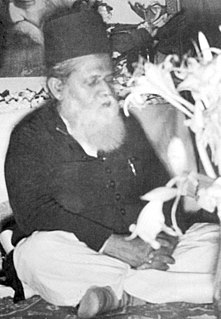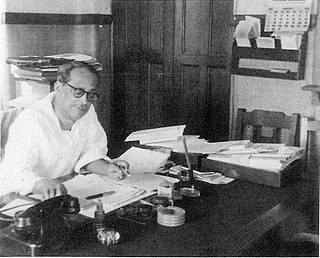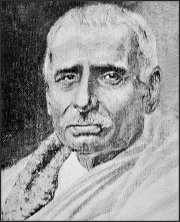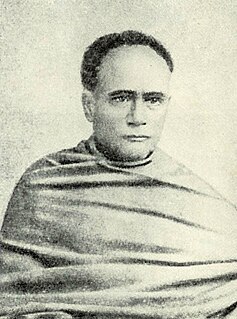
Muhammad Shahidullah was a Bengali educationist, writer, philologist and linguist of East Pakistan.

The Charyapada is a collection of mystical poems, songs of realization in the Vajrayana tradition of Buddhism from the tantric tradition during the Pala Empire in Ancient Assam, Bengal, Bihar, Orissa.

Paschimbanga Bangla Akademi, popularly known as Bangla Akademi, is the official regulatory body of the Bengali language in West Bengal. Modeled after Bangla Academy of Bangladesh and France’s Académie française, the Bangla Akademi was founded on May 20, 1986 in Kolkata to act as the official authority of the language and is entrusted with the responsibility of reforming Bengali spelling and grammar, compiling dictionaries, encyclopedias and terminologies and promoting Bengali language and culture in West Bengal. Though the Akademi has no enforcement power over their rules and regulations, yet they are widely accepted by the Governments of West Bengal and Tripura as well as a considerable number of private publishing houses and institutions like the Oxford University Press and the Ramakrishna Mission.

Bengali literature denotes the body of writings in the Bengali language. The earliest extant work in Bengali literature is the Charyapada, a collection of Buddhist mystic songs dating back to the 10th and 11th centuries. Thereafter, the timeline of Bengali literature is divided into two periods − medieval (1360-1800) and modern.

This is a History of Bengali Literature.

Bengalis, also rendered as the Bengali people, Bangalis and Bangalees, are an Indo-Aryan ethnic group native to the Bengal region in South Asia, specifically in the eastern part of the Indian subcontinent, presently divided between Bangladesh and the Indian states of West Bengal, Tripura, Assam's Barak Valley, who speak Bengali, a language from the Indo-Aryan language family. The term "Bangalee" is also used to denote people of Bangladesh as a nation.

Rai Bahadur Dinesh Chandra Sen was a Bengali writer, educationist and researcher of Bengali folklore from the Indian subcontinent. He was the founding faculty member and the Ramtanu Lahiri Research Fellow of the Department of Bengali Language and Literature of the University of Calcutta. He died in Calcutta in 1939.
Fort William College was an academy and learning centre of Oriental studies established by Lord Wellesley, then Governor-General of British India. The law to establish its foundation was passed on 4 May 1800, to commemorate the first anniversary of the victory over Tipu Sultan at Seringapatam. It was founded on 10 July 1800, within the Fort William complex in Calcutta. Thousands of books were translated from Sanskrit, Arabic, Persian, Bengali, Hindi, and Urdu into English at this institution.
The Ramacharitam is a Sanskrit epic poem written in Arya metre by Sandhyakar Nandi during Pala Empire, between approximately 1050 and 1150 CE. This work simultaneously narrates the story of the Ramayana and the Pala king Ramapala. The work is biased in favour of Ramapala, but remains an important historical source for the Pala history.

See Tagore for disambiguation
Bipradas Pipilai was a 15th-century poet. He was the son of Mukunda Pipilai, the family hailed from Baduria-Batagram in 24 Parganas, now in the Indian state of West Bengal.

Raja Rajendralal Mitra was the first modern Indologist of Indian origin and the first scientific historiographer from Bengal. He was a pioneer figure in the Bengali renaissance and was a noted antiquarian and archaeologist.
Jyotirishwar Thakur or Kaviśekharācārya Jyotirīśvara Ṭhākura (1290–1350) was a Maithil poet and an early Maithili and Sanskrit writer, known for the Varṇa Ratnākara, his encyclopedic work in Maithili.

Prabodh Chandra Bagchi or P. C. Bagchi was one of the most notable Sino -Indologists of the 20th century. He was the third Upacharya (Vice-Chancellor) of Visva-Bharati University.

Benimadhab Barua was a Bengali Indian scholar of ancient Indian languages, Buddhism and law. He was a prominent educationist and writer.

Bangadarshan was a Bengali literary magazine, founded by Bankim Chandra Chattopadhyay in 1872, and resuscitated in 1901 under the editorship of Rabindranath Tagore. The magazine had a defining influence on the emergence of a Bengali identity and the genesis of nationalism in Bengal.

Kamrupi literature is the literature written in the Kamrupi. The Kamrupi is ancient eastern most Indo-European language which literature flourished from earlier times to 19th century.
Cecil Bendall was an English scholar, a professor of Sanskrit at University College London and later at the University of Cambridge.

Sanjib Chandra Chattopadhyay was a Bengali writer, poet and journalist. He was the elder brother of Bankim Chandra Chattopadhyay
Sushil Kumar De was a Bengali polymath from the early decades of the 20th century. Trained as a lawyer, with degrees in English and Sanskrit Poetics, he wrote extensively on Sanskrit Literature, Philosophy, Poetics, History of Bengali Literature, besides editing critical editions for a large number of Sanskrit and Bengali texts from manuscripts.





















